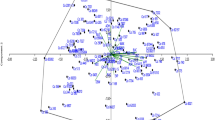Summary
The major characters which account for the variation among the mango varieties in Nigeria were studied using PCA and SCLA. Thirty-one varieties were collected in all ecological zones of the country. Altogether 64 characters were observed and coded for analysis. The results from both methods divided the varieties into two or four groups. The PCA showed that the combination of qualitative and quantitative data as well as combination of few vegetative characters with many reproductive characters are important for mango classification. The primary and secondary characters in classification of mango varieties are discussed.
Similar content being viewed by others
References
Bemis, W.P., A.M., Rhodes, T.W., Whitaker & S.G., Carmer, 1970. Numerical taxonomy applied to Curcubita relationships Amer. J. Bot. 57: 404–417.
Bruno, A. & P.H., Golberg, 1963. The morphology and chemical composition of some Nigeria mangoes (Mangifera indica L.). Jour. Imp. Coll. Trop. West Ind. 19 (2): 143–152.
Burns, W. & S.H. Prayag, 1921. The book of Mango. Bombay Department of Agriculture, Publisher.
Cattell, R.B., 1965. Factor analysis an introduction to essentials. 1 The purpose underlying models. Biometrics. 22: 190–215.
Egharevba, R.K. 1975. Consumption patterns and preference for fruits and vegetables in Nigeria. Ed. O.O. Ojehomon & P.A. Town. Proc. Nat. Semina on fruits and vegetables. NIHORT Ibadan Publisher.
Gittins, R. 1969. The application of ordination techniques. In: H., Rorison (Ed.). Biological aspects of Mineral Nutrition. Blackwell Scientific Publishers, Oxford.
Godfrey-Sam-Aggrey, W.G.M. & W.S., Abutiate, 1973. Description of some mango cultivars in Ghana. Ghana Jour. Agric. Sc. 6: 33–42.
Hou, D. 1972. The new species of Mangifera (Anacardiaceae). Reinwardtia 8 (2): 323–327.
Hutchinson, J. & J.N., Dlaziel, 1963. Flora of tropical West Africa Vol. 2. p. 727. Crown Agents, London.
Illoh, H.C. 1986. Taxonomic evaluation of mango (Magifera indica. L.) varieties in Nigeria. Ph.D. Thesis submitted to University of Ife, Ile-Ife, Nigeria.
Isawumi, M.A. 1982. A numerical taxonomic study of genus Vernonia and hybrids tribe Vernonieae (Compositae). Ph.D. thesis submitted to University of Ife, Ile-Ife, Nigeria.
Isawumi, M.A. 1985. Infrageneric classification of Vernonia tribe Vernonieae (Compositae) in West Africa using the techniques of numerical taxonomy. Nigeria Jour. Sci. 19 (1–2): 68–78.
Keay, R.W.J., C.F.A. Onocie & D.P. Satnfield, 1964. Nigerian Trees. Vol. II. Forestry Research Institute of Nigeria, Publishers.
Kim, J., 1970. Factor Analysis. In: N.A. Nie, C.H. Hull, J.G. Jenkins, K. Steinbrenner & D.H. Bent (Eds). Statistical Package for Social Siences SPSS.
Lefevbre, A., 1973. Introduction of cultivated varieties of mangoes to Madagascar (Majunga). Fruits. 28 (9): 645–647.
Maries, C., 1902. Indian mangoes. J.R. Hort. Sc. 26: 755.
Mukherjee, S.K., 1948. The varieties of mango (Manfigera indica L.) and their classification. Bull. Bot. Soc. Beng. 2: 101–133.
Mukherjee, S.K. 1953. The mango-its botany cultivation, uses and future improvements, especially as observed in India. Econ. Bot. 7: 130–162.
Onyiliagha, J.C. 1986. Numerical analysis of variation among Nigerian Dioscorea rotundata accessions. Euphytica. 35: 413–419.
Pickersgill, B., C.B., Heiser & J., McNeill, 1978. Numerical taxonomic studies on variation and domestication in some species of Capsicum. In: J.G., Hawkes, R.N., Lester & A.D., Skelding (Eds). The Biology and taxonomy of the Solanceae pp. 679–700 Academic Press, New York.
Popenoe, W. 1955. Manual of tropical and Sub-tropical fruits. Macmillan Publishers, London.
Rhodes, A.M., C., Campbell, S.E., Malo & S.G., Carner, 1970. A numerical taxonomic study of mango Mangifera indica L. J. Amer. Soc. Hort. Sci. 95 (2): 252–256.
Rhodes, A.M. & F.M., Martins, 1972. Multivariate studies in variations of yams (Dioscorea alata L.) J. Amer. Soc. Hort. Sci. 97: 685–688.
Schilling, E.E. & C.B., Heiser, 1976. Re-examination of numerical study of Solanum species and hybrids. TAXON 25: 451–562.
Singh, L.B., 1968. The mango, Botany, Cultivation and Utilization. Leonard Hill Publishers, London.
Sokal, R.R. & P.H.A. Sneath, 1963. Principles of Numerical Taxonomy W.H. Freman and Co. San Francisco Publisher.
Sturrock, T.T. & W.S. Wolfe, 1944. A key to Florida mango varieties. Proc. Fla. Hort. Sci. 175–180.
Woodhouse, E.H., 1909. The mangoes of Bhagalpur. Quart. J. Dept. Agric. Beng. 2: 168.
Author information
Authors and Affiliations
Rights and permissions
About this article
Cite this article
Illoh, H.C., Olorode, O. Numerical taxonomic studies of mango (Mangifera indica L.) varieties in Nigeria. Euphytica 51, 197–205 (1990). https://doi.org/10.1007/BF00039719
Received:
Accepted:
Issue Date:
DOI: https://doi.org/10.1007/BF00039719




